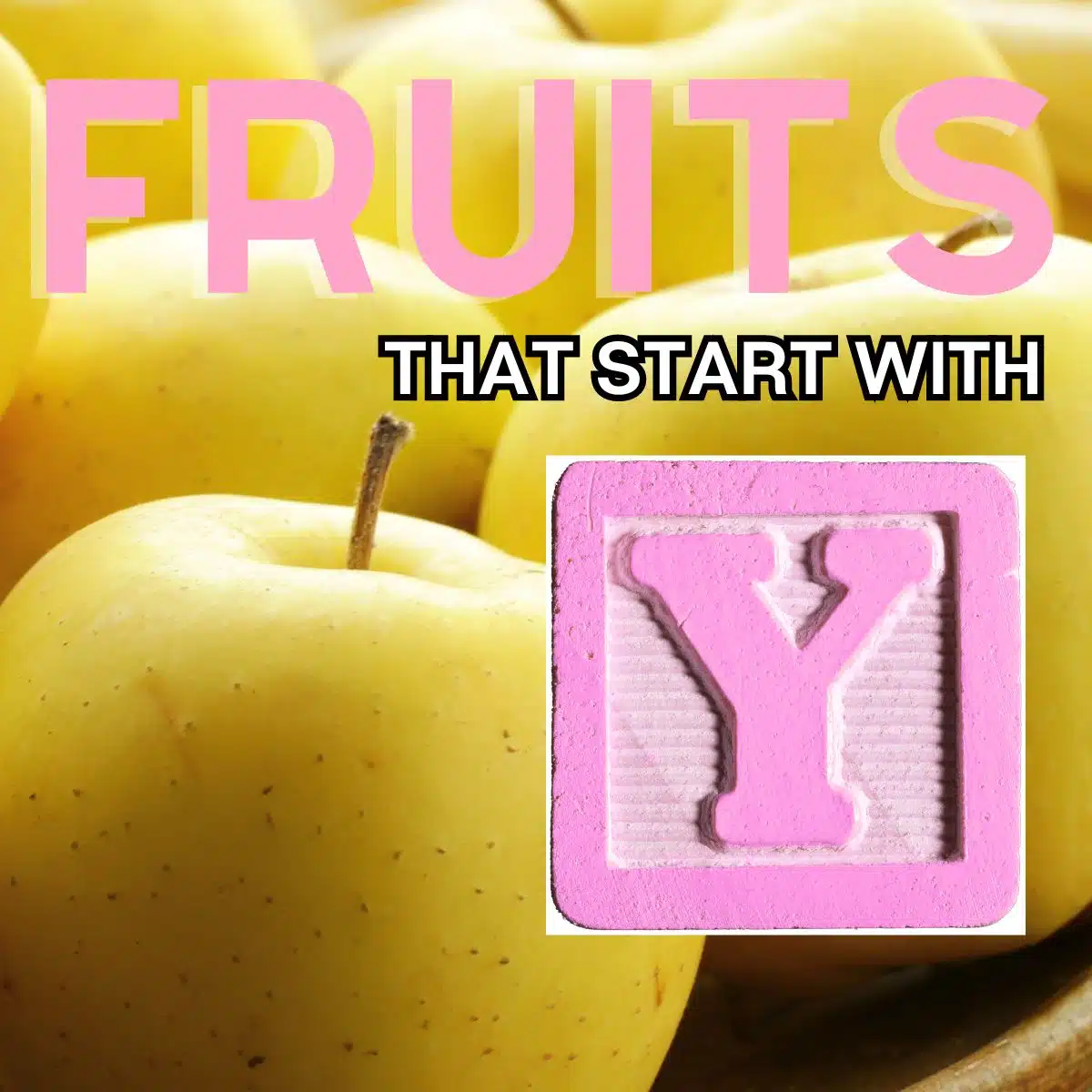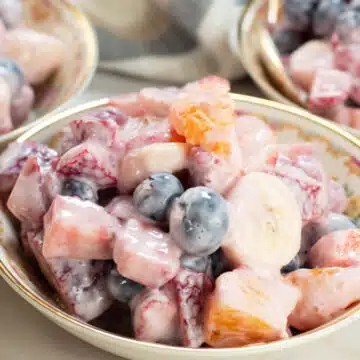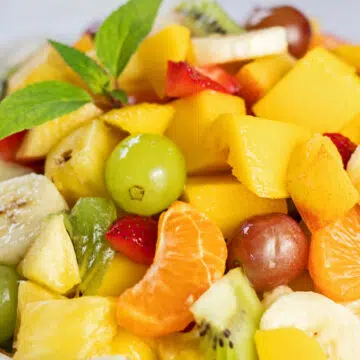This fruits that start with Y list features every fruit beginning with Y, from tropical treats to well-loved favorites! Whether you're brushing up on trivia or eating your way through the alphabet, this list is for you! From pear varieties to berries and everything in between, you're certain to find some fruits you want to try!

Jump to:
- 19 Fruits Beginning With Y
- 1. Ya Pear
- 2. Yali Pear
- 3. Yangmei Fruit
- 4. Yellow Apple
- 5. Yellow Dragon Fruit
- 6. Yellow Guava
- 7. Yellow Passion Fruit
- 8. Yellow Plum
- 9. Yellow Sapote
- 10. Yellow Squash
- 11. Yellow Watermelon
- 12. Yemenite Citron
- 13. York Imperial Apple
- 14. Young Mango
- 15. Youngberry
- 16. Yucca Fruit
- 17. Yumberry
- 18. Yunnan Hackberry Fruit
- 19. Yuzu
- Best Fruits That Start With Y
- 📖 Recipe Card
- Fruits That Start With Y: 19+ Fruits To Try Today!
- 💬 Comments & Reviews
19 Fruits Beginning With Y
Whether you came across an unfamiliar fruit while preparing a recipe or want to try something new, this list of fruits beginning with Y is here to help! You can learn more about these fruits from all over the world!
Make sure you check out all of my other fruits that start with lists so you don't miss out on anything! Let's get started!
1. Ya Pear
Ya pears, also known as Chinese white pears, are similar in shape and size to comice pears, but they stand out with their white appearance. These pears are not only juicy and sweet but also crunchy.
They have a unique flavor that combines floral and tropical notes.

2. Yali Pear
The Yali pear, native to Eastern Asia in countries like Japan, Korea, China, and Taiwan, is known by various names such as sand pear, apple pear, and duck pear.
It has a round shape and turns yellow when ripe. Loved for its sweet, juicy flavor and crisp texture, the yali pear is commonly enjoyed fresh or used in salads. Additionally, people use it to create tasty sauces to complement roasted or grilled meats.

3. Yangmei Fruit
Yangmei, a fruit native to South-Central China and Taiwan, is known by several names like waxberry, China bayberry, and red barberry. People enjoy its berries in different forms – fresh, dried, and canned, as well as in various beverages like beer and wine.
4. Yellow Apple
Yellow apples come in around 15 different varieties, including classic, newer, and imported types from countries like Russia, Scotland, and Denmark. Among these, the most popular is the golden delicious.
With its thin yellow skin, the taste of this apple varies depending on where it's grown but generally offers a sweet flavor. Enjoy it fresh, in jams or sauces, as a pie filling, or even preserved to complement sandwiches or burgers.

5. Yellow Dragon Fruit
The yellow dragon fruit, also known as pitaya, is a tropical fruit with vibrant yellow skin and sweet, mildly tangy flesh. With its scaly exterior resembling dragon scales, this fruit is visually striking.
When you slice open the smooth outer layer, you'll discover a refreshing interior filled with tiny black seeds, making it a great addition to fruit salads or a tasty standalone snack.

6. Yellow Guava
Yellow guava, despite having less vitamin C than other varieties, still packs more than oranges, making it a nutritious choice. Its smooth yellow rind covers a light yellow interior with edible seeds.
Surprisingly, some enjoy the entire fruit, including the skin. The sweet and lemony taste makes it perfect for raw consumption or as a flavorful addition to cooking jams, jellies, smoothies, and juices.
7. Yellow Passion Fruit
Yellow passion fruits may not be the prettiest, and when you cut them open, they might seem a bit strange. These fruits are usually round or egg-shaped, with thick, yellow skins.
Inside, you'll find white flesh with yellow-orange pulp and dark brown seeds, all of which are edible. The taste is sweet and carries a tropical, floral-like flavor. Enjoy them fresh, as toppings on yogurt or ice cream, in cooking, or transformed into delicious jams, syrups, and pie fillings.
8. Yellow Plum
Yellow plums, numbering around 40 species, are found in diverse regions such as Australia, the US, and Asia. Both the skin and flesh have a vibrant yellow color, and these plums typically have a small, round, or oval shape.
Yellow plums can be enjoyed fresh or preserved, with options ranging from jams and jellies to wine.
>>>>See all of my recipes here<<<<
9. Yellow Sapote
Yellow sapote, also known as canistel or egg fruit, offers a sweet and musky flavor with a texture resembling boiled egg yolk. The ripened fruit has a vibrant lemon-yellow or pale orange-yellow color.
Whether enjoyed raw or made into tasty treats like milkshakes, jams, or marmalades, yellow sapote provides a unique and tasty experience.
10. Yellow Squash
Yellow squash is a vibrant and versatile fruit from the gourd family. Its smooth, bright yellow skin and mild flavor add a burst of color and taste to various dishes.
Yellow squash is versatile, whether sliced into salads, grilled to perfection, or sautéed in a stir-fry.

11. Yellow Watermelon
Yellow watermelons closely resemble their red counterparts on the outside, sharing the same size and shape with green rinds. However, upon slicing them open, they reveal a vibrant yellow color, similar to a banana.
While their taste is similar to red watermelons, they offer a slightly sweeter flavor, with some comparing it to apricots.
12. Yemenite Citron
The Yemenite citron, often called the "original citrus fruit," traces its roots back to biblical times. Resembling lemons in shape but significantly larger, with some featuring bumpy rinds, this citrus fruit stands out.
The thick, inedible rind is similar to many other citrus varieties. Despite its sour and bitter pulp, it finds its place in various recipes and holds special significance in Jewish celebrations.
13. York Imperial Apple
The York imperial apple is a tasty choice with a unique appearance. While not as juicy as Fuji apples, they have a great balance between sweetness and tartness.
Enjoy them raw, with or without the skin, or get creative by baking, juicing, or trying other cooking methods.

14. Young Mango
Originating in South Florida, young mangoes are a blend of Kent and Edward mango varieties. These round, golden-yellow fruits have an orange blush on some parts of their skin.
Once sliced open, their pale yellow interiors resemble a lemon, and their taste is subtly sweet and mild. While not among the most popular mango varieties, young mangoes still make a tasty treat.

15. Youngberry
Resembling blackberries but smaller, youngberries have a purple-black color when ripe. Due to their sweet taste, they are commonly used in making jellies, jams, juice, wine, syrup, and desserts like youngberry pie and cheesecake.
16. Yucca Fruit
Yucca fruit is not a typical fruity snack, but it can come in handy. While it doesn't taste too bad, especially when grilled or roasted, its flavor leans more towards a vegetable similar to that of a bell pepper.
17. Yumberry
Yumberries, primarily cultivated in China, are only ripe for a brief two-week window each year. These berries have a delicate nature, and most people encounter their flavor through juices rather than the berries themselves, which prove challenging to preserve, transport, or sell.
If you're fortunate enough to enjoy a fresh yumberry, you'll taste a combination of tartness similar to that of a blend of pomegranate seeds and cranberries.
18. Yunnan Hackberry Fruit
Yunnan hackberries are small, resembling grapes or cherries with their red and purple colors. With a dry and crunchy skin, these fruits have a single, edible seed.
Unlike typical juicy fruits, they resemble colorful nuts with a slightly sweet exterior. Some are tough for raw consumption but transform into a tasty and nutritious yunnan hackberry paste when processed.
19. Yuzu
Yuzu fruits resemble crinkled oranges and are citrus fruits found in various parts of Asia. Unlike their sweet counterparts, these fruits are extremely sour and tart, making them unsuitable for raw consumption by most people.
However, they find their way into recipes much like lemons and limes, adding a zesty flavor. They are also popular as a garnish, especially in seafood and mixed drinks.
Best Fruits That Start With Y
Yellow squash is one of my favorite summertime fruits to cook with! I also love yellow watermelon for a refreshing treat or yellow apples for snacking!
What do you think of these fruits that start with Y? Leave a comment and let me know which one of these fruits is your favorite!
Do you love a recipe you tried? Please leave a 5-star 🌟rating in the recipe card below and/or a review in the comments section further down the page.
Stay in touch with me through social media @ Pinterest, Facebook, Instagram, or Twitter! Subscribe to the newsletter today (no spam, I promise)! Don't forget to tag me when you try one of my recipes!
📖 Recipe Card
Fruits That Start With Y: 19+ Fruits To Try Today!
Ingredients
Yellow Squash Bread
- 3 large eggs (beaten, at room temperature)
- 1½ cups sugar
- 1 cup vegetable oil
- 2 teaspoon vanilla extract
- 3 cups all-purpose flour
- 3 teaspoon baking powder
- 2 teaspoon ground cinnamon
- 1 teaspoon ground nutmeg
- 2 cups yellow squash (shredded - *see note)
Lemon Icing (Optional)
- ½ cup confectioners sugar
- 1 tablespoon lemon juice (more as needed)
- lemon zest (optional, for sprinkling over icing)
(Note: 2x or 3x only changes the ingredient list)
Instructions
Make The Bread
- To begin, preheat your oven to 325°F (165°C) and lightly grease a 9x13 baking dish (*see note).
- Add your eggs to a large mixing bowl and use a hand mixer to beat them until they are fluffy with plenty of bubbles.
- Add in the sugar, oil, and vanilla. Beat the mixture to thoroughly combine the ingredients. Add the baking powder, cinnamon, and nutmeg then mix until evenly distributed.
- Mix in the flour, scraping the sides and bottom of your mixing bowl until smooth. *Your batter will be fairly thick. Gently fold the shredded squash into the batter and then transfer the mixture to the prepared pan.
- Bake for about 45 minutes at 325°F (165°C), or until a toothpick inserted into the center comes out almost clean (*see note for baking times using different pan sizes).
- Once the bread is done baking, remove it from the oven and allow it to cool before drizzling with icing.
Make The Lemon Icing
- In a small mixing bowl, combine the confectioners' sugar and lemon juice. Stir gently to combine. Adjust the consistency by adding small amounts of powdered sugar (to thicken) or lemon juice (to thin).
- Once you are satisfied with the consistency of the icing, use a spoon to drizzle it over the cooled squash bread. Sprinkle with lemon zest, if desired.
Notes
- Choose young squash (crookneck or straight neck) for the best flavor! It is best to pick up squash that are small to medium in size, as they are more flavorful. Large squash can lose flavor and become watery.
- To give this bread a twist, you can add on a tasty crumb topping instead of the lemon icing!
- You can also use this recipe to make muffins, just follow the same instructions and bake for 20 minutes!
- If using an 8x4 loaf pan, bake for about 60 minutes. A mini loaf pan will bake for about 50 minutes.
- If using a loaf pan instead of a 9x13 baking dish, this recipe will yield about 1 standard loaf pan as well as 2 mini loaf pans.
- For some great texture, add some almonds, pecans, or raisins to your batter!
- To store: In a sealed container, this bread will keep for 2-3 days on the counter at room temperature. In the fridge, it can last for 1 week.
- To freeze: This bread freezes great! Wrap it tightly in plastic wrap and then place the loaves into a Ziploc bag. Simply thaw the loaves on the counter when you want to enjoy this bread again, any time of year!



Comments
No Comments